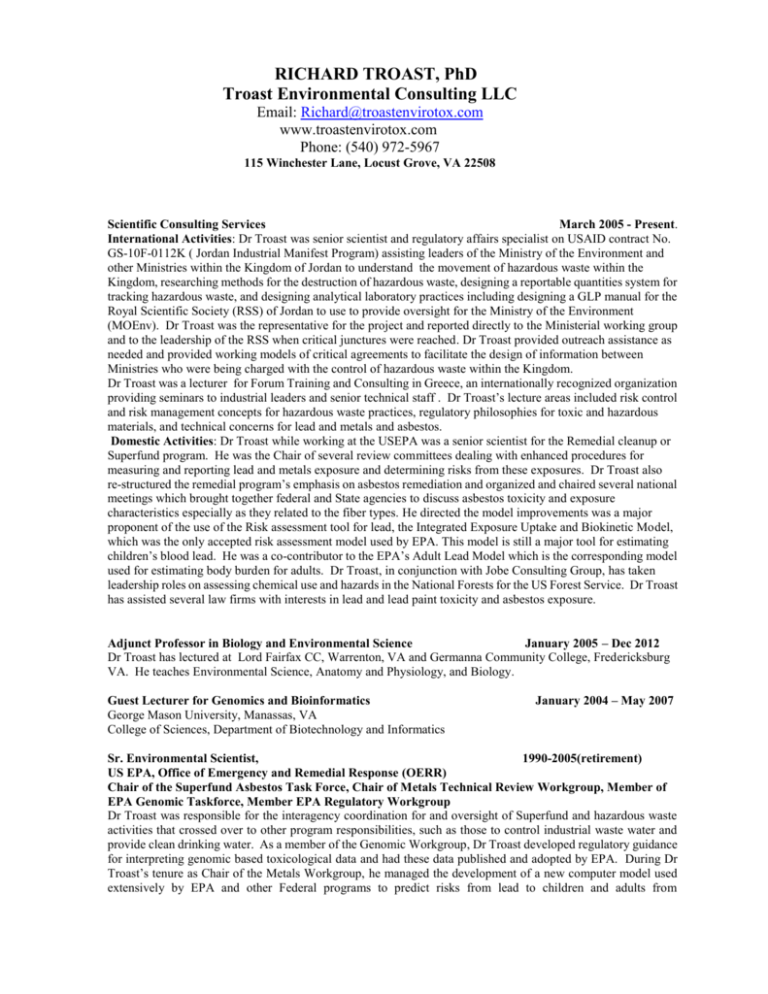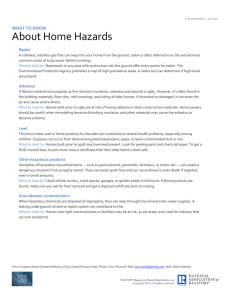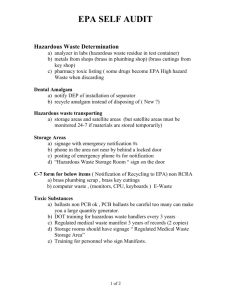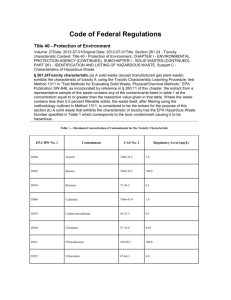RICHARD TROAST - s3.amazonaws.com
advertisement

RICHARD TROAST, PhD Troast Environmental Consulting LLC Email: Richard@troastenvirotox.com www.troastenvirotox.com Phone: (540) 972-5967 115 Winchester Lane, Locust Grove, VA 22508 Scientific Consulting Services March 2005 - Present. International Activities: Dr Troast was senior scientist and regulatory affairs specialist on USAID contract No. GS-10F-0112K ( Jordan Industrial Manifest Program) assisting leaders of the Ministry of the Environment and other Ministries within the Kingdom of Jordan to understand the movement of hazardous waste within the Kingdom, researching methods for the destruction of hazardous waste, designing a reportable quantities system for tracking hazardous waste, and designing analytical laboratory practices including designing a GLP manual for the Royal Scientific Society (RSS) of Jordan to use to provide oversight for the Ministry of the Environment (MOEnv). Dr Troast was the representative for the project and reported directly to the Ministerial working group and to the leadership of the RSS when critical junctures were reached. Dr Troast provided outreach assistance as needed and provided working models of critical agreements to facilitate the design of information between Ministries who were being charged with the control of hazardous waste within the Kingdom. Dr Troast was a lecturer for Forum Training and Consulting in Greece, an internationally recognized organization providing seminars to industrial leaders and senior technical staff . Dr Troast’s lecture areas included risk control and risk management concepts for hazardous waste practices, regulatory philosophies for toxic and hazardous materials, and technical concerns for lead and metals and asbestos. Domestic Activities: Dr Troast while working at the USEPA was a senior scientist for the Remedial cleanup or Superfund program. He was the Chair of several review committees dealing with enhanced procedures for measuring and reporting lead and metals exposure and determining risks from these exposures. Dr Troast also re-structured the remedial program’s emphasis on asbestos remediation and organized and chaired several national meetings which brought together federal and State agencies to discuss asbestos toxicity and exposure characteristics especially as they related to the fiber types. He directed the model improvements was a major proponent of the use of the Risk assessment tool for lead, the Integrated Exposure Uptake and Biokinetic Model, which was the only accepted risk assessment model used by EPA. This model is still a major tool for estimating children’s blood lead. He was a co-contributor to the EPA’s Adult Lead Model which is the corresponding model used for estimating body burden for adults. Dr Troast, in conjunction with Jobe Consulting Group, has taken leadership roles on assessing chemical use and hazards in the National Forests for the US Forest Service. Dr Troast has assisted several law firms with interests in lead and lead paint toxicity and asbestos exposure. Adjunct Professor in Biology and Environmental Science January 2005 – Dec 2012 Dr Troast has lectured at Lord Fairfax CC, Warrenton, VA and Germanna Community College, Fredericksburg VA. He teaches Environmental Science, Anatomy and Physiology, and Biology. Guest Lecturer for Genomics and Bioinformatics George Mason University, Manassas, VA College of Sciences, Department of Biotechnology and Informatics January 2004 – May 2007 Sr. Environmental Scientist, 1990-2005(retirement) US EPA, Office of Emergency and Remedial Response (OERR) Chair of the Superfund Asbestos Task Force, Chair of Metals Technical Review Workgroup, Member of EPA Genomic Taskforce, Member EPA Regulatory Workgroup Dr Troast was responsible for the interagency coordination for and oversight of Superfund and hazardous waste activities that crossed over to other program responsibilities, such as those to control industrial waste water and provide clean drinking water. As a member of the Genomic Workgroup, Dr Troast developed regulatory guidance for interpreting genomic based toxicological data and had these data published and adopted by EPA. During Dr Troast’s tenure as Chair of the Metals Workgroup, he managed the development of a new computer model used extensively by EPA and other Federal programs to predict risks from lead to children and adults from environmental releases into waste streams and drinking water. Dr Troast began the review of in vitro methods for establishing exposure parameters for metals. This review was completed post-retirement and published outside of EPA. While he chaired the Asbestos Task Force, the group developed new methods for asbestos sampling, and for identifying asbestos fibers in the environment, and developed a new exposure/risk paradigm to account for differing toxicity values among the various forms of asbestos, and developed a revised risk assessment method used for amphibole asbestos. Dr Troast also chaired numerous national conferences and public meetings for both the Metals and Asbestos programs and these meetings were well received by the scientific community, concerned citizens and local governments. Member of the ILSI Health and Environmental Sciences Institute (HESI) work group 2001-2005 As a member of this workgroup which was comprised of comprised of leading industry and Federal scientists the charge was to develop a basis for a mutual understanding of applying genomic data to toxicology. A major concern was to harmonize data assessment among the Federal programs that use the information for health and safety reviews. Office of Pesticides and Toxic Substances, Chemical Testing Branch (TSCA) 1980-1989 As branch and section leader Dr Troast had oversight for the analysis of chemical and toxicological data supplied by industry using the authorities of TSCA sections 4, 5 and 8 to determine whether further data was required to fully understand and characterize the potential toxicity of chemicals that were potentially released via industrial processes to near-by populations. A key function was the design of the testing requirements for chemicals whose database was viewed as unacceptable under the standards of the Toxic Substances Control Act. Chemical testing programs were tracked and managed according to the rule that was published requiring that affected industries to develop the data. Studies were analyzed and recommendations made for further action if required. Legislative Fellow 1987-1988 Dr Troast was selected by US Office of Personnel Management to serve as a LEGIS Fellow for the second session of the 97th Congress. In this capacity Dr Troast served with Senator Gordon Humphrey (R-NH) as a legislative aide focusing on environmental legislation pending before the US Senate. Significant actions included legislation on Amending the Clean Air Act, The Clean Water Act, Toxic Air Pollutants, Asbestos in Schools, and Radon. Office of Pesticide Programs (FIFRA) US EPA 1973-1980 Responsibilities included reviewing scientific supporting data for pesticide applications, and establishing criteria for removing or limiting pesticide usage based upon toxicological data. Education: Bachelor of Arts- Biology, West Virginia University 1969 Master of Science- Biochemistry, West Virginia University 1972 PhD- Environmental Science and Public Policy, George Mason University 2006 Fairfax VA, Department of Environmental Science and Policy Dissertation Title “The Effect of Environmental Lead and Identification of Biomarkers as Signals of Cellular Toxicity Using Genomic Tools in Caenorhabditis elegans- A Study in Science and Policy.” Study emphasis in genomic toxicology, and bioinformatics Professional Training: Executive Development Seminar in Science Technology and Public Policy, US OPM 1992 Executive Development Seminar for Managers in Science and Technology, US OPM, 1988 Legislative Fellowship 1987-88 Office of Personnel Management Contract and Task Management Certification, General Services Adminsistration Honors and Awards: Silver Medal for Superior Service from EPA Bronze Medal for Meritorious Service from EPA US EPA Project Management Excellence Award LEGIS Fellowship 2002 1982, 1987, and 1991 1993 1987-1988 US EPA Special Achievement Awards 1983, 1987, 1990, 1992, and 1997 Military Service Lt Colonel USAR Retired 1995 Senior Staff and Command staff positions: Commanding Officer 419 Chemical Detachment, Andrews Air Force Base, MD, Chemical Officer, 310th Theater Army Command, Ft Belvoir, VA; 97th US Army Reserve Command, Ft Meade; 352 nd Civil Affairs Command, Riverdale, MD; and US Army Civil Affairs and Psychological Operations Command Ft Bragg, NC. The primary responsibilities included investigating doctrine on troop safety and environmental decontamination from a variety of standard and non-standard sources. Security Clearances Top Secret (DA Form 873, July 1991-June 2004), Secret (March 15, 2006) Professional Publications and Presentations: Maddaloni, M, M. Ballew, G. Diamond, MH Follansbee, D. Gefell, P. Goodrum, M. Johnson, K. Koporec, G. Khoury, J. Luey, M. Odin, R.Troast, P. Van Leeuwen, L. Zaragoza. Assessing Adult Non-Residential Lead Risks at Hazardous Waste Sites. Journal of Human and Ecological Risk (2005) Issues Related to Time Averaging of Exposure in Modeling Risks Associated with Intermittent Exposures to Lead. Lorenzana, R., R. Troast, JM Klotzbach, MH Follansbee, and GL Diamond, Risk Analysis (2003) Lead Intervention and Pediatric Blood Lead Levels at Hazardous Waste Sites. Lorenzana, R., R. Troast, M. Mastriano, M. Follansbee, GL Diamond J of Tox and Env Health, Part A 66:871-893, 2003 Probing Mechanisms of Toxicity through Metabolic Profiling: Lead and Caenhorabditis elegans Willett, JD, R Troast and G. Sudama Presentation at International Conference on Genomics and Science, Cyprus, Greece October 2004 A New Technique for Assessing Lead Bioavailability Troast, R. and JD Willett Presentation at 14 th Annual Conference on Soils, Sediments and Water sponsored by Assn for Environmental Health and Science San Diego CA March 2004 Metabolic Profiling and the Mechanisms of Toxicity: Lead and Caenhorabditis elegans Willett, J., R Troast and G. Sudama Presentation at 2003 Mechanisms of Genotoxity, Princeton University Lead Induced Physiologic Changes in Caenhorabditis elegans Troast, R and J.D. Willett Presentation at Medical College of Virginia Genotoxicity Symposium; Richmond, VA May2002 The Use of Genomic Markers in Caenorhabditis elegans as bio-indicators for environmental lead exposure: A replacement for current in vivo and in vitro systems? Presentation at Tenth International Conference of Biomarkers Baltimore, Md. April 2006 Genomics: Challenges and Opportunities for the US Environmental Protection Agency. Gallagher, K, et al. of Env. Health Perspectives; 12(3):572 (2006) Identification of an Exposure Based Biomarker for Lead using Caenorhabditis elegans. Troast, R., JD Willett and G. Sudama J of American Scientists (2007) Biochemical Markers of Lead Exposure. Troast, R and J.D.Willett. J Env Bioindicators 3:68-73 (2008) Professional Memberships Society Of Toxicology J. American Association for the Advancement of Science American Chemical Society









